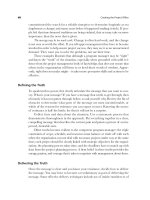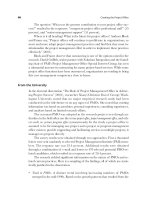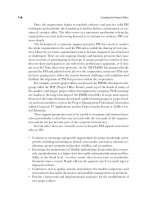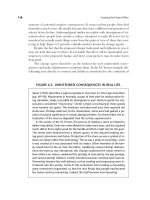remote. office not required - jason fried
Bạn đang xem bản rút gọn của tài liệu. Xem và tải ngay bản đầy đủ của tài liệu tại đây (4.79 MB, 142 trang )
More Praise for Remote
“What you’ll find in Remote is profound advice from guys who’ve succeeded in the virtual
workforce arena. This is a manifesto for discarding stifling location- and time-based organizational
habits in favor of best work practices for our brave new virtual and global world. If your
organization entrusts you with the responsibility to get things done, this is a must-read.”
—David Allen, internationally bestselling author of
Getting Things Done: The Art of Stress-Free Productivity
“Remote is the way I work and live. Now I know why. If you work in an office, you need to read
this remarkable book, and change your life.”
—Richard Florida, author of the national bestseller The Rise of the Creative Class: And How It’s
Transforming Work, Leisure, Community and Everyday Life
“In the near future, everyone will work remotely, including those sitting across from you. You’ll
need this farsighted book to prepare for this inversion.”
—Kevin Kelly, senior maverick for Wired magazine and
author of What Technology Wants
“Leave your office at the office. Lose the soul-sapping commutes. Jettison the workplace veal
chambers and banish cookie-cutter corporate culture. Smart, convincing, and prescriptive, Remote
offers a radically more productive and satisfying office-less future, better for all (well, except
commercial landlords).”
—Adam L. Penenberg, author of Viral Loop: From Facebook to Twitter, How Today’s Smartest
Businesses Grow Themselves
“Shows how remote working sets people free—free from drudgery and free to unleash
unprecedented creativity and productivity. The first gift copy I buy will be for my boss!”
—James McQuivey, PhD, VP and principal analyst at Forrester Research, and author of Digital
Disruption: Unleashing the Next Wave of Innovation
“Just like we couldn’t imagine a cell phone smaller than a toaster in the 1970s, some companies still
believe that they can’t get great performance from their employees unless they show up at an office.
Virtual work is the wave of the future, and Jason and David do a brilliant job of teaching best
practices for both employees and employers.”
—Pamela Slim, author of Escape from Cubicle Nation: From Corporate Prisoner to Thriving
Entrepreneur
“Jason and David convincingly argue the merits of remote work, both from the perspective of
manager and of worker … Remote work gives you the power to craft your own life, and this book
is a road map to get that.”
—Penelope Trunk, author of Brazen Careerist: The New Rules for Success
“The decentralization of the workplace is no longer fodder for futurists, it’s an everyday reality.
Remote is an insight-packed playbook for thriving in the coming decade and beyond.”
—Todd Henry, author of The Accidental Creative: How to Be Brilliant at a Moment’s Notice
“Remote shows you how to remove the final barrier to doing the work you were meant to do,
with the people you were meant to do it with, in the most rewarding and profitable way possible
—this book is your ticket to real freedom!”
—John Jantsch, author of Duct Tape Marketing: The World’s Most Practical Small Business
Marketing Guide
“Remote is not just a powerful toolbox … It’s full of fascinating insights into collaboration,
innovation, and the human mind.”
—Leo Babauta, author of Zen Habits: Handbook for Life
Cover
Authors’ Note
Introduction
THE TIME IS RIGHT FOR REMOTE WORK
Why work doesn’t happen at work
Stop commuting your life away
It’s the technology, stupid
Escaping 9am–5pm
End of city monopoly
The new luxury
Talent isn’t bound by the hubs
It’s not about the money
But saving is always nice
Not all or nothing
Still a trade-off
You’re probably already doing it
DEALING WITH EXCUSES
Magic only happens when we’re all in a room
If I can’t see them, how do I know they’re working?
People’s homes are full of distractions
Only the office can be secure
Who will answer the phone?
Big business doesn’t do it, so why should we?
Others would get jealous
What about culture?
I need an answer now!
But I’ll lose control
We paid a lot of money for this office
That wouldn’t work for our size or industry
HOW TO COLLABORATE REMOTELY
Thou shalt overlap
Seeing is believing
All out in the open
The virtual water cooler
Forward motion
The work is what matters
Not just for people who are out of town
Disaster ready
Easy on the M&Ms
BEWARE THE DRAGONS
Cabin fever
Check-in, check-out
Ergonomic basics
Mind the gut
The lone outpost
Working with clients
Taxes, accounting, laws, oh my!
HIRING AND KEEPING THE BEST
It’s a big world
Life moves on
Keep the good times going
Seeking a human
No parlor tricks
The cost of thriving
Great remote workers are simply great workers
On writing well
Test project
Meeting them in person
Contractors know the drill
MANAGING REMOTE WORKERS
When’s the right time to go remote?
Stop managing the chairs
Meetups and sprints
Lessons from open source
Level the playing field
One-on-ones
Remove the roadblocks
Be on the lookout for overwork, not underwork
Using scarcity to your advantage
LIFE AS A REMOTE WORKER
Building a routine
Morning remote, afternoon local
Compute different
Working alone in a crowd
Staying motivated
Nomadic freedom
A change of scenery
Family time
No extra space at home
Making sure you’re not ignored
CONCLUSION
The quaint old office
The Remote Toolbox
Acknowledgments
Epigraph
Dedication
Copyright
Thank You for Reading Our Book
About 37 Signals
AUTHORS’ NOTE
When we started writing this book in 2013, the practice of working remotely—or telecommuting, as
it’s often referred to—had been silently on the rise for years. (From 2005 to 2011 remote work
soared 73 percent in the United States—to 3 million workers total.
*
)
The silence was loudly broken at the end of February 2013, though, when Yahoo! announced that
they were dismantling their remote-work program, just as we were finishing this book. All of a
sudden, remote work moved from academic obscurity to a heated global conversation. Hundreds, if
not thousands, of news articles were written, and controversy was in the air.
Of course, we would have appreciated Yahoo!’s CEO Marissa Mayer waiting another six months
for our publication date. That said, her move provided a unique backdrop against which to test all of
Remote’s arguments. As it turned out, every single excuse you’ll find in the essay titled “Dealing with
excuses” got airtime during the Yahoo! firestorm.
Needless to say, we don’t think Yahoo! made the right choice, but we thank them for the spotlight
they’ve shined on remote work. It’s our aim in this book to look at the phenomenon in a much more
considered way. Beyond the sound bites, beyond all the grandstanding, what we’ve provided here is
an in-the-trenches analysis of the pros and cons—a guide to the brave new world of remote work.
Enjoy!
* http://www.globalworkplaceanalytics.com/telecommuting-statistics
INTRODUCTION
The future is already here—it’s just not
evenly distributed.
—WILLIAM GIBSON
Millions of workers and thousands of companies have already discovered the joys and benefits of
working remotely. In companies of all sizes, representing virtually every industry, remote work has
seen steady growth year after year. Yet unlike, say, the rush to embrace the fax machine, adoption of
remote work has not been nearly as universal or commonsensical as many would have thought.
The technology is here; it’s never been easier to communicate and collaborate with people
anywhere, any time. But that still leaves a fundamental people problem. The missing upgrade is for
the human mind.
This book aims to provide that upgrade. We’ll illuminate the many benefits of remote work,
including access to the best talent, freedom from soul-crushing commutes, and increased productivity
outside the traditional office. And we’ll tackle all the excuses floating around—for example, that
innovation only happens face-to-face, that people can’t be trusted to be productive at home, that
company culture would wither away.
Above all, this book will teach you how to become an expert in remote work. It will provide an
overview of the tools and techniques that will help you get the most out of it, as well as the pitfalls
and constraints that can bring you down. (Nothing is without trade-offs.)
Our discussion will be practical, because our knowledge comes from actually practicing remote
work—not just theorizing about it. Over the past decade, we’ve grown a successful software
company, 37signals, from the seeds of remote work. We got started with one partner in Copenhagen
and the other in Chicago. Since then we’ve expanded to thirty-six people spread out all over the
globe, serving millions of users in just about every country in the world.
We’ll draw on this rich experience to show how remote work has opened the door to a new era of
freedom and luxury. A brave new world beyond the industrial-age belief in The Office. A world
where we leave behind the dusty old notion of outsourcing as a way to increase work output at the
lowest cost and replace it with a new ideal—one in which remote work increases both quality of
work and job satisfaction.
“Office not required” isn’t just the future—it’s the present. Now is your chance to catch up.
CHAPTER
THE TIME IS
RIGHT FOR REMOTE WORK
Why work doesn’t happen at work
If you ask people where they go when they really need to get work done, very few will respond “the
office.” If they do say the office, they’ll include a qualifier such as “super early in the morning before
anyone gets in” or “I stay late at night after everyone’s left” or “I sneak in on the weekend.”
What they’re trying to tell you is that they can’t get work done at work. The office during the day
has become the last place people want to be when they really want to get work done.
That’s because offices have become interruption factories. A busy office is like a food processor
—it chops your day into tiny bits. Fifteen minutes here, ten minutes there, twenty here, five there.
Each segment is filled with a conference call, a meeting, another meeting, or some other
institutionalized unnecessary interruption.
It’s incredibly hard to get meaningful work done when your workday has been shredded into work
moments.
Meaningful work, creative work, thoughtful work, important work—this type of effort takes
stretches of uninterrupted time to get into the zone. But in the modern office such long stretches just
can’t be found. Instead, it’s just one interruption after another.
The ability to be alone with your thoughts is, in fact, one of the key advantages of working
remotely. When you work on your own, far away from the buzzing swarm at headquarters, you can
settle into your own productive zone. You can actually get work done—the same work that you
couldn’t get done at work!
Yes, working outside the office has its own set of challenges. And interruptions can come from
different places, multiple angles. If you’re at home, maybe it’s the TV. If you’re at the local coffee
shop, maybe it’s someone talking loudly a few tables away. But here’s the thing: those interruptions
are things you can control. They’re passive. They don’t handcuff you. You can find a space that fits
your work style. You can toss on some headphones and not be worried about a coworker loitering by
your desk and tapping you on the shoulder. Neither do you have to be worried about being called into
yet another unnecessary meeting. Your place, your zone, is yours alone.
Don’t believe us? Ask around. Or ask yourself: Where do you go when you really have to get work
done? Your answer won’t be “the office in the afternoon.”
Stop commuting your life away
Let’s face it: nobody likes commuting. The alarm rings earlier, you arrive home that much later. You
lose time, patience, possibly even your will to eat anything other than convenience food with plastic
utensils. Maybe you skip the gym, miss your child’s bedtime, feel too tired for a meaningful
conversation with your significant other. The list goes on.
Even your weekends get truncated by that wretched commute. All those chores you don’t have the
will to complete after slugging it out with the highway collect into one mean list due on Saturday. By
the time you’ve taken out the trash, picked up the dry cleaning, gone to the hardware store, and paid
your bills, half the weekend is gone.
And the commute itself? Even the nicest car won’t make driving in traffic enjoyable, and forget
feeling fresh after a trip on most urban trains and buses. Breathe in the smell of exhaust and body
odor, breathe out your health and sanity.
Smart people in white coats have extensively studied commuting—this supposedly necessary part
of our days—and the verdict is in: long commutes make you fat, stressed, and miserable. Even short
commutes stab at your happiness.
According to the research,
*
commuting is associated with an increased risk of obesity, insomnia,
stress, neck and back pain, high blood pressure, and other stress-related ills such as heart attacks and
depression, and even divorce.
But let’s say we ignore the overwhelming evidence that commuting doesn’t do a body good.
Pretend it isn’t bad for the environment either. Let’s just do the math. Say you spend thirty minutes
driving in rush hour every morning and another fifteen getting to your car and into the office. That’s
1.5 hours a day, 7.5 hours per week, or somewhere between 300 and 400 hours per year, give or take
holidays and vacation. Four hundred hours is exactly the amount of programmer time we spent
building Basecamp, our most popular product. Imagine what you could do with 400 extra hours a
year. Commuting isn’t just bad for you, your relationships, and the environment—it’s bad for
business. And it doesn’t have to be that way.
It’s the technology, stupid
If working remotely is such a great idea, why haven’t progressive companies been practicing it all
along? It’s simple: they couldn’t. The technology just wasn’t there. Good luck trying to collaborate
with people in different cities, let alone halfway around the world, using a fax machine and FedEx.
Technology snuck up on us and made working remotely an obvious possibility. In particular, the
Internet happened. Screen sharing using WebEx, coordinating to-do lists using Basecamp, real-time
chatting using instant messages, downloading the latest files using Dropbox—these activities all flow
from innovations pioneered in the last fifteen years. No wonder we’re still learning what’s possible.
But past generations have been bred on the idea that good work happens from 9am to 5pm, in
offices and cubicles in tall buildings around the city. It’s no wonder that most who are employed
inside that model haven’t considered other options, or resist the idea that it could be any different. But
it can.
The future, quite literally, belongs to those who get it. Do you think today’s teenagers, raised on
Facebook and texting, will be sentimental about the old days of all-hands-on-deck, Monday morning
meetings? Ha!
The great thing about technology, and even working remotely, is that it’s all up to you. It’s not
rocket science, and learning the tools that make it possible won’t take that long either. But it will take
willpower to let go of nostalgia and get on board. Can you do that?
Escaping 9am–5pm
The big transition with a distributed workforce is going from synchronous to asynchronous
collaboration. Not only do we not have to be in the same spot to work together, we also don’t have to
work at the same time to work together.
This is one of those things that’s born out of necessity when collaborating with people in multiple
time zones, but it benefits everyone, even those in the same city. Once you’ve structured your work
technique and expectations to deal with someone seven hours ahead in Copenhagen, the rest of the
home office in Chicago might as well work from 11am to 7pm or 7am to 3pm—it’s all the same.
The beauty of relaxing workday hours is that the policy accommodates everyone—from the early
birds to the night owls to the family folks with kids who need to be picked up in the middle of the day.
At 37signals, we try to keep a roughly forty-hour workweek, but how our employees distribute those
hours across the clock and days just isn’t important.
A company that is efficiently built around remote work doesn’t even have to have a set schedule.
This is especially important when it comes to creative work. If you can’t get into the zone, there’s
rarely much that can force you into it. When face time isn’t a requirement, the best strategy is often to
take some time away and get back to work when your brain is firing on all cylinders.
At the IT Collective, a film production and video marketing firm based in Colorado (but with
people in New York and Sydney too), the team of editors will occasionally switch to nocturnal mode
when working on a new film. It’s simply how they get their best work done. The next day the editors
will overlap with the rest of the team just long enough to review progress and get direction for the
next night. Who cares if they slept way past noon to make that schedule work?
Naturally, not all work can be done entirely free of schedule restrictions. At 37signals, we offer
customer support to people on American business hours, so it’s important our customer support team
is available during that time. But even within those constraints, relaxed schedules are still a
possibility so long as the group as a whole is covering the full spectrum.
Release yourself from the 9am-to-5pm mentality. It might take a bit of time and practice to get the
hang of working asynchronously with your team, but soon you’ll see that it’s the work—not the clock
—that matters.
End of city monopoly
The city is the original talent hub. Traditionally, those who ran the engines of capitalism thought:
“Let’s gather a large number of people in a small geographical area where they must live on top of
each other in tight quarters, and we’ll be able to find plenty of able bodies to man our factories.”
Most splendid, Sir Moneybags!
Thankfully, the population-density benefits that suited factories proved great for lots of other things
too. We got libraries, stadiums, theaters, restaurants, and all the other wonders of modern culture and
civilization. But we also got cubicles, tiny apartments, and sardine boxes to take us from here to
there. We traded the freedom and splendor of country land and fresh air for convenience and
excitement.
Lucky for us, the advances in technology that made remote working possible have also made
remote culture and living much more desirable. Imagine describing to a city dweller of the 1960s a
world in which everyone has access to every movie ever made, every book ever written, every album
ever recorded, and nearly every sports game live (in higher quality and better colors than at any time
in the past). Surely, they would have laughed. Hell, even in the 1980s they would have laughed. But
here we are living in that world.
There’s a difference, though, between taking it for granted and taking it to the logical conclusion. If
we now have unlimited access to culture and entertainment from any location, why are we still
willing to live bound by the original deal? Is that overpriced apartment, the motorized sardine box,
and your cubicle really worth it still? Increasingly, we believe that for many people the answer will
be no.
So here’s a prediction: The luxury privilege of the next twenty years will be to leave the city. Not
as its leashed servant in a suburb, but to wherever one wants.
The new luxury
A swanky corner office on the top floor of a tall building, a plush company-provided Lexus, a
secretary. It’s easy to laugh at old-money corporate luxuries. But the new-money, hip ones aren’t all
that different: a fancy chef and free meals, laundry services, massages, a roomful of arcade games.
They’re two sides of the same coin.
That’s the coin given in exchange for the endless hours spent at the office. Away from your family,
your friends, and your extracurricular passions. The hope is that these enticements will tide you over
during those long years when you’re dreaming of all the things you’ll do when you retire.
But why wait? If what you really love doing is skiing, why wait until your hips are too old to take a
hard fall and then move to Colorado? If you love surfing, why are you still trapped in a concrete
jungle and not living near the beach? If all the family members you’re close to live in a small town in
Oregon, why are you still stuck on the other coast?
The new luxury is to shed the shackles of deferred living—to pursue your passions now, while
you’re still working. What’s the point in wasting time daydreaming about how great it’ll be when you
finally quit?
Your life no longer needs to be divided into arbitrary phases of work and retirement. You can
blend the two for fun and profit—design a better lifestyle that makes work enjoyable because it’s not
the only thing on the menu. Shed the resentment of golden handcuffs that keep you from living how you
really want to live.
That’s a much more realistic goal than buying lottery tickets, either the literal or figurative ones. As
an example of the latter: pursuing a career-ladder or stock-option scheme and hoping your number
hits before it’s too late to matter.
You don’t need to be extraordinarily lucky or hardworking to make your work life fit with your
passions—if you’re free to pick where to work from and when to work.
This doesn’t mean you have to pick up and move to Colorado tomorrow, just because you like
skiing. Some people do that, but there are many possible in-betweens as well. Could you go there for
three weeks? Just like working from the office, it doesn’t have to be all or nothing.
The new luxury is the luxury of freedom and time. Once you’ve had a taste of that life, no corner
office or fancy chef will be able to drag you back.
Talent isn’t bound by the hubs
If you talk to technologists from Silicon Valley, moviemakers from Hollywood, or advertising execs
from New York, they’ll all insist that the magic only happens on their sacred turf. But that’s what
you’d expect talent hub nationalists to say. You’re the fool if you believe it.
“Look at the history,” they’ll say, pointing to proud traditions bearing glorious results. Yes, yes, but
as the fine print reads on investment materials: “Past performance is no guarantee of future results.”
So here’s another set of unremarkable predictions: The world’s share of great technology from
Silicon Valley will decline, the best movies of the next twenty years will consist of fewer Hollywood
blockbusters, and fewer people will be induced to buy products from admen in New York.
Great talent is everywhere, and not everyone wants to move to San Francisco (or New York or
Hollywood, or wherever you’re headquartered). 37signals is a successful software company started
in—gasp!—the Midwest, and we’re proud to have hired spectacular employees from such places as
Caldwell, Idaho, and Fenwick, Ontario.
In fact, we don’t have a single employee in San Francisco, the hub where every technology
company seems to be tripping over itself to find “rock stars” and “software ninjas.” This hasn’t been
a conscious choice on our part, but given the poaching games being played in major hubs, with people
changing jobs as often as they might reorder their iPhone playlists, it’s not exactly a net negative.
When you have dozens, even hundreds, of competitors within walking distance of your office, it
should come as no surprise when your employees cross the street and join the next hot thing.
As we’ve observed, star employees who work away from the echo chambers of industry spend far
less time brooding about how much greener the grass is on the other side and, generally, seem happier
in their work.
It’s not about the money
When people hear the term “remote workers,” they often think “outsourcing.” They assume that
remote work is just another ploy dreamed up by business fat cats to cut costs and ship jobs to
Bangalore. That’s an understandable gut reaction. It’s also wrong.
Letting people work remotely is about promoting quality of life, about getting access to the best
people wherever they are, and all the other benefits we’ll enumerate. That it may also end up
reducing costs spent on offices and result in fewer-but-more-productive workers is the gravy, not the
turkey.
Though our suggesting that remote work benefits both employer and employee may sound overly
chipper and have you thinking of the sentiment expressed in those cheesy posters from the 1990s, WIN-
WIN!, the reality is that, for everyone, there is much to like about the practice. Too much writing on
work is pitched as either pro-employer or pro-worker. While those struggles are real, they’re not the
struggles we’re interested in examining.
Besides, the key intellectual pursuits that are the primary fit for remote working—writing,
programming, designing, advising, and customer support, to mention just a few—have little to do with
the cutthroat margin wars of, say, manufacturing. Squeezing slightly more words per hour out of a
copywriter is not going to make anyone rich. Writing the best ad just very well might.
But saving is always nice
So remote work isn’t primarily about the money—but who doesn’t like saving as a side effect? It
certainly makes a great argument if you’re trying to convince a manager.
Money, in fact, is the perfect Trojan horse for getting the bean counters on your side. Make them
see dollar signs where you see greater freedom, more time with the family, and no commute, and
you’ll both get what you want.
When trying to convince said bean counters, there’s no logic like big company logic—so here’s
some from IBM,
†
the bluest of blue chips:
Through its telework strategy, since 1995, IBM has reduced office space by a total of 78 million
square feet. Of that, 58 million square feet was sold at a gain of $1.9B. And sublease income for
leased space not needed exceeded $1B. In the U.S., continuing annual savings amounts to
$100M, and at least that much in Europe. With 386,000 employees, 40 percent of whom
telework, the ratio of office space to employee is now 8:1 with some facilities as high as 15:1.
Who can argue against billions saved? Certainly not the gang trying to get you to save on staplers
and printing paper. And the savings aren’t just for the company. While the firm’s owners get to save
on office space, the employee gets to save on gas. HP’s Telework Calculator
‡
shows a savings of
almost $10,000 per year for an SUV driver who spends an hour a day commuting ten miles round trip.
Cutting back on commuting also means huge savings for the environment. That same IBM study
showed how remote work saved the company five million gallons of fuel in 2007, preventing more
than 450,000 tons of CO
2
emissions to the atmosphere in the United States alone.
Helping the company’s bottom line, adding to your pocketbook, and saving the planet: check,
check, check.
Not all or nothing
Embracing remote work doesn’t mean you can’t have an office, just that it’s not required. It doesn’t
mean that all your employees can’t live in the same city, just that they don’t have to. Remote work is
about setting your team free to be the best it can be, wherever that might be. Across companies, large
and small, flexible remote-working strategies can be found in all sizes and shapes. Furniture maker
Herman Miller’s knowledge and design team is entirely remote, working from ten different cities
around the United States. At digital communications company Jellyvision 10 percent of the workforce
is completely remote, another 20 percent works from home a couple days a week, and the rest work
regularly from the company headquarters in Chicago.
In 1999, 37signals’ original team of four began with a nice, traditional office in Chicago. After a
few years, we realized it didn’t make sense for us—the place was too big, the rent too high—so we
got rid of it. We moved to the corner of another design firm, where we rented a handful of desks for
$1,000 per month. Soon we had more than a handful of employees, but it didn’t matter. David joined
from Copenhagen, and over the years we hired more programmers and designers from all over the
world. But we stayed in that design-firm corner, saving rent and enjoying the hassle-free setup, for
close to a decade!
Now we have thirty-six employees and a West Loop Chicago office we helped design. It’s got a
small theater for presentations and a ping-pong table, and on any given day ten employees work there.
Is it worth it? We think so, but we wouldn’t have said the same thing ten years ago, and probably not
even five. Is it required? Absolutely not, but we’ve earned it. It’s a luxury, not a necessity—although
it sure is nice that a few times a year all our employees can fly in for a company-wide gathering, and
we have an awesome space to meet.
For other companies where the trappings of success are an important part of the image—for
example, advertising agencies or law firms or C-level recruiting outfits—having a showy office may
make sense. Acknowledging that the office is there to impress clients sets an owner or manager free
to make it the best theater experience it can be—and employees can remain free to work from home
when they’re not needed as extras for the scene.









